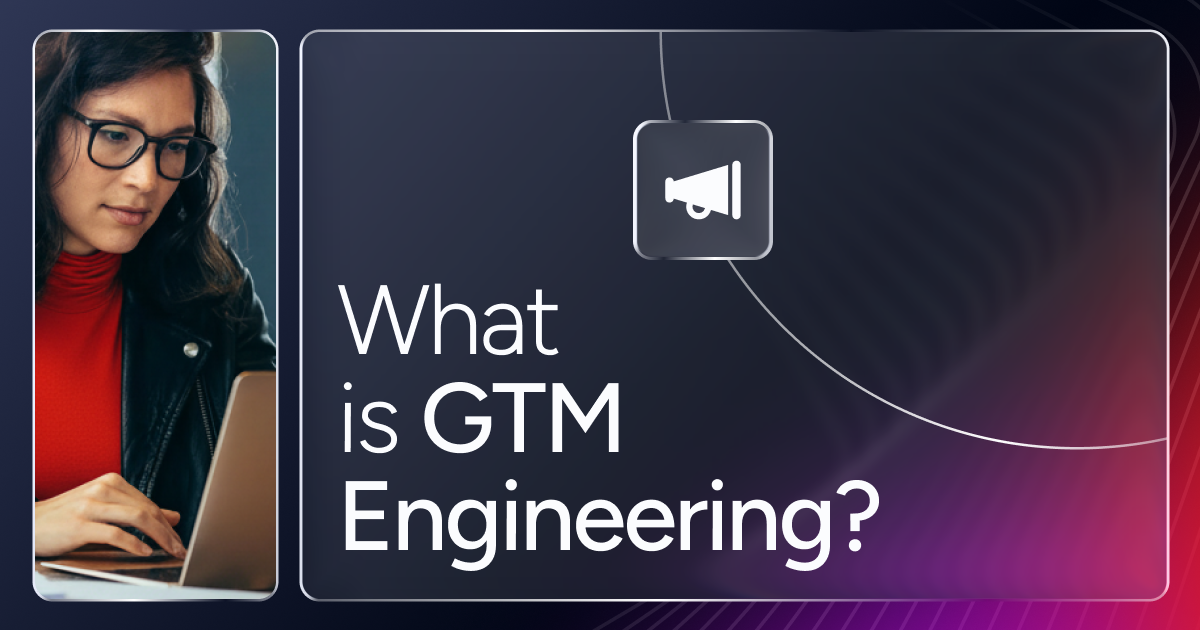Introduction to GTM engineering
GTM (go-to-market) engineering is the application of an engineering mindset to sales, marketing, and RevOps to build, automate, and scale the systems that drive revenue. GTM engineering is how modern revenue teams scale. It’s a discipline focused on designing and automating the systems that power growth, from tools and data pipelines to workflows and signals.
The concept spans software infrastructure, data pipelines, and workflow automation, all working together to help GTM teams move faster, stay aligned, and execute without friction.
GTM engineering is still a new idea, but a clear pattern is emerging. It’s a go-to-market engineering framework built to support the internal systems that marketing, sales, customer success, and RevOps rely on every day.
Some describe it as revenue systems engineering. Others see it as the next evolution of revenue operations (RevOps). Either way, it’s a critical function for companies building scalable, efficient, and intelligent GTM motions.
Defining GTM Engineering
GTM engineering is about architecting and operationalizing the systems — tools, APIs, workflows, data flows — that power modern go-to-market execution. It bridges the gap between manual work and automated revenue systems.
Where RevOps manages and optimizes existing tools and processes, GTM engineering builds. It designs net-new infrastructure to help revenue teams adapt faster, move cleaner, and work from a shared source of truth.
Why GTM Engineering Is Emerging Now
Three major forces are driving demand for GTM engineering:
Tech stack complexity: Most B2B GTM teams run complex tech stacks with dozens of tools, and without tight integration, those tools create silos that drag everything down.
Speed and scale pressure: Teams need to launch faster, automate more, and respond to market signals in real time.
Shift to systems-led growth: GTM is no longer just people-led. It’s systems-led. The infrastructure matters.
GTM engineering is how companies make those systems work together, reduce manual friction, and scale motion across the funnel.
What is a GTM Engineer?
A GTM (Go-to-Market) engineer is a technical specialist who builds, integrates, and optimizes the systems and workflows that support sales, marketing, and customer success teams in executing a company’s go-to-market strategy. “GTM Engineer” is an emerging job title that first appeared in Google Trends in April 2025:

How GTM Engineers Support Revenue Teams
GTM engineers sit at the intersection of strategy and technical execution. They:
Integrate tools such as CRMs, MAPs, analytics, enrichment, and product usage systems
Build workflows across the full lifecycle, from inbound lead to renewal
Automate lead scoring and routing, handoffs, and campaign execution
Create feedback loops and dashboards for real-time visibility
Example: A GTM engineer might connect product usage data with CRM records and trigger alerts to the customer success team when engagement drops, giving them time to act to reduce the risk of customer churn.
This work enables GTM teams to run coordinated, data-driven motions. It also gives leadership accurate views into conversion, velocity, and risk.
Beyond operational efficiency, GTM engineers help unify the customer journey across touchpoints. By stitching together marketing engagement, product usage, sales interactions, and support data, they ensure that each team sees the full customer context, reducing blind spots and enabling more relevant outreach.
They also serve as force multipliers for experimentation. A team might want to A/B test lead routing by segment or change qualification logic by region. Without GTM engineering, that work could take weeks. With the right workflows and data infrastructure in place, those experiments can launch in days with clean measurement and fast iteration.
What Makes GTM Engineering Different from RevOps
RevOps optimizes what exists. GTM engineering builds what’s missing.
A RevOps leader might adjust lead scoring models or clean Salesforce reports. A GTM engineer, by contrast, builds the system that routes leads, automates follow-ups, and integrates data across five tools.
One improves the output. The other builds the machine.
Business Benefits of GTM Engineering
By fixing the systems under the hood, GTM engineering helps revenue teams run faster, spend smarter, and operate with fewer gaps. The impact shows up in cost, speed, and how well teams execute together.
Faster speed to market. Less time lost to manual setup and broken handoffs. Workflow automation and system integration are proven to accelerate GTM execution.
Higher revenue efficiency. Cleaner data and automated processes reduce customer acquisition cost (CAC). SMB and midmarket companies that use ZoomInfo’s GTM Intelligence Platform to augment engineered workflows saw a 31% drop in customer acquisition cost. Enterprise teams reported an even greater 42% reduction.
Stronger cross-functional alignment: When systems talk to each other, so do teams.
Smarter decisions. Integrated data and reporting power faster GTM optimization. Firms using automation report improved outcomes in lead routing, conversion, and productivity.
Key Responsibilities of GTM Engineers
1. Technology integration
GTM engineers connect the systems revenue teams rely on. They create a bridge between CRM, MAP, enrichment, and usage analytics so data flows without friction. This means owning APIs, data pipelines, and platform configurations.
2. Workflow automation
They automate lead management, outreach, onboarding, and renewal workflows, eliminating repetitive work, reducing lag time, and giving reps more time to sell.
3. Data hygiene and quality
GTM engineers maintain schema, resolve identity issues, and keep data accurate and current, laying the foundation for every GTM motion to run cleanly.
4. Dashboarding and reporting
They build dashboards and alerts to show GTM performance in real time. This helps teams iterate fast and act on what’s working.
5. Embedding AI and intelligence
GTM engineers plug AI tools into workflows such as predictive lead scoring or next-best actions so the system doesn’t just run. It gets smarter over time.
Skills GTM Engineers Need
GTM engineers blend technical ability with commercial understanding. They typically bring:
Experience with CRMs, MAPs, analytics platforms, APIs, and data integration tools
Ability to build automation using no-code/low-code platforms, or write scripts when needed
Knowledge of funnel metrics, sales processes, and customer lifecycle dynamics
Skill in translating business goals into technical builds (e.g. turning a "15-minute lead response SLA" into an automated routing system)
They also need to communicate across functions, aligning with marketing, sales, customer success, and leadership. Their work only works if teams adopt and trust the systems they build.
The Role of AI and GTM Intelligence Platforms
Modern GTM engineering demands more than plumbing and pipes. It demands intelligence. The right platform becomes the engine, not just the tool‑belt. Here’s how platforms such as ZoomInfo play that role.
1. Centralised data and real‑time signals
GTM engineers rely on clean, connected data to build workflows that work across teams. ZoomInfo centralises first- and third-party data, from firmographics and intent to product usage, into a single reliable foundation.
That means engineers can access accurate, up-to-date data without stitching together five disconnected sources.
Real-time signals give those systems urgency. Instead of building workflows that wait on lagging indicators, GTM engineers can trigger actions such as lead routing, CSM alerts, campaign launches, based on live engagement and fit data. The result is faster reactions, cleaner execution, and systems that act when the market does.
These capabilities let GTM engineers build workflows where incoming signals (such as intent, technographics, and engagement) instantly trigger actions across systems
2. Workflow automation and intelligent triggering
With the right platform, GTM engineers can build workflows that respond to real‑world signals rather than wait for manual inputs.
ZoomInfo Copilot shows reps which accounts to focus on, flags shifts in the buying committee, and drafts outreach that’s ready to go. Then it delivers that intel straight into their workflow so they can move.
In practice this means:
Leads come in, enrichment runs automatically
Intent spikes, workflow triggers a task to the SDR queue
Buying committee changes, AI recommends the next human move
Dashboard updates in real‑time, RevOps sees the gap before the rep does
3. Cleaner data equals connected systems
GTM engineering thrives on accurate, connected systems. Data that’s late, missing, or siloed kills velocity.
GTM engineers ensure:
Enrichment delivered via API so data flows into CRMs and MAPs
Real‑time updates on contacts, organisations, and technographics
Built-in support for common sales engagement and marketing platforms so systems stay connected and data moves without friction
This is what makes a revenue systems engineering approach viable. You lean on a foundation platform, accelerate build time, and reduce custom‑engineering overhead.
4. Embedding intelligence into GTM systems
In GTM engineering, AI becomes actionable leverage. The platform does the work while the team focuses on the strategy.
ZoomInfo Copilot, for instance, uses generative AI to craft emails, surface next-best moves, and prioritize targets. When you connect this back to GTM engineering, the engineer builds a system in which an intent signal combined with enrichment data prompts AI to recommend the next action, which then triggers the workflow that moves the seller. The chain is seamless.
That’s precisely what a revenue systems engineering discipline demands, which is a system that doesn't just run, but responds, adapts, and scales.
GTM Engineering Is Revenue Infrastructure
If you’re scaling a modern GTM motion, GTM engineering isn’t optional. It’s the function that makes your systems work together. It also makes your teams faster, more efficient, and more aligned. Don’t isolate it in IT or bury it in ops. Build it into your GTM strategy.
Define the outcomes that matter, such as conversion, speed, and retention, and let GTM engineers own the infrastructure behind them.
GTM engineering may be an emerging discipline, but the impact is real. It’s how growth teams move from potential to performance, and it’s what separates the teams who talk about scale from the ones who achieve it.


